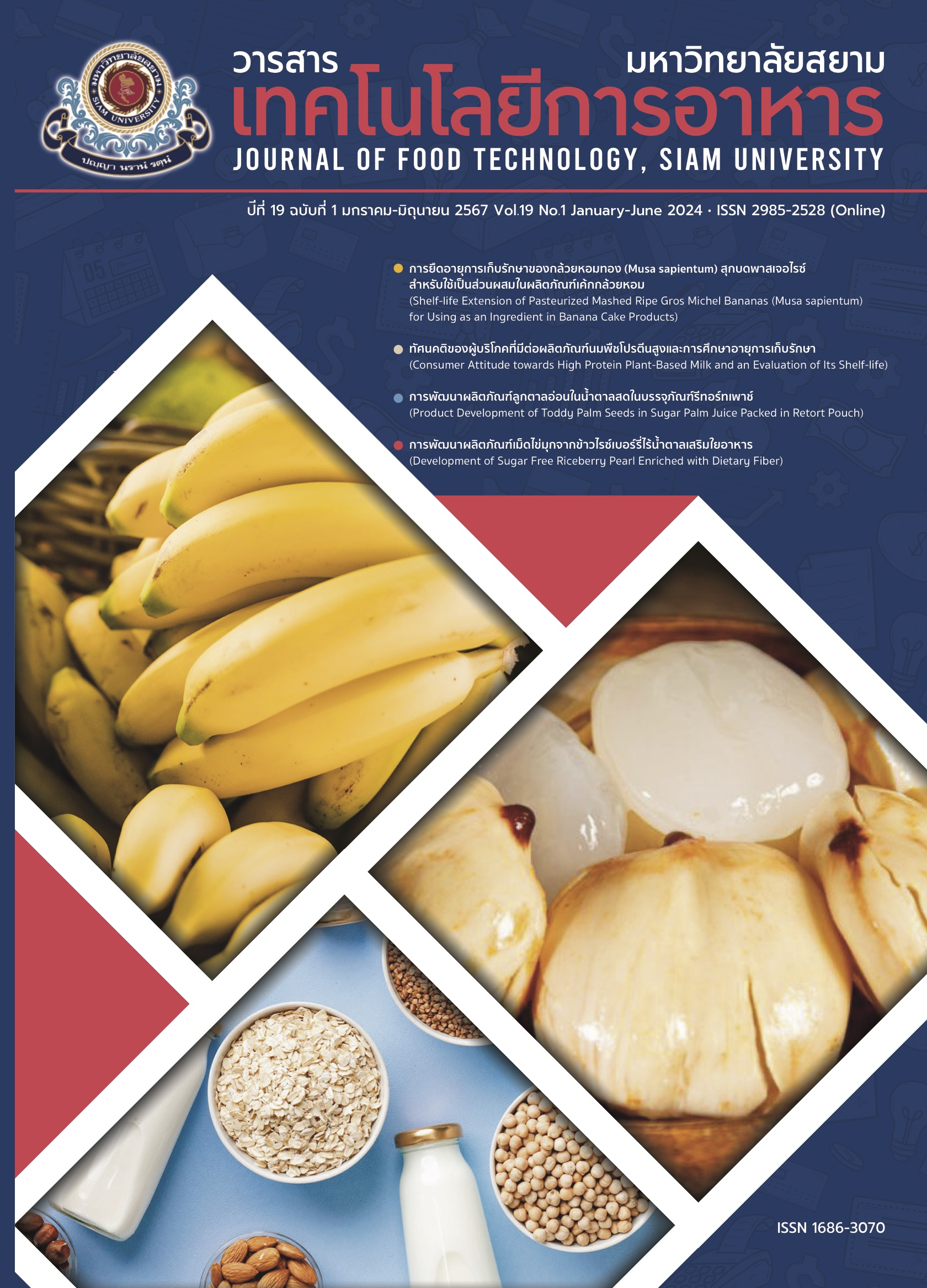Shelf-life Extension of Pasteurized Mashed Ripe Gros Michel Bananas (Musa sapientum) for Using as an Ingredient in Banana Cake Products
Main Article Content
Abstract
This research studied the appropriate conditions for preparing pasteurized mashed ripe Gros Michel bananas (banana puree). The two factors studied were the type and quantity of browning inhibitors. The production of banana cake from pasteurized ripe Gros Michel bananas, the properties of pasteurized ripe golden banana cake and the sensory evaluation of pasteurized ripe golden banana cake were studied. The results of the experiment found that it was possible to increase utilization by extending the shelf life while maintaining the quality of the bananas similar to fresh ripe Gros Michel bananas. The bananas were ground then added with 2% citric acid, packed in vacuum packaging, pasteurized with 15 second heating at 72 oC. It can be stored in the refrigerator at 4 oC for up to 1 month. The result of color showed that banana puree had L* at 72.55, a* at 2.06, and b* at 28.94. The utilization of the mashed banana to make banana cake showed that banana cake formulated with 2% citric acid had a higher adhesiveness and hardness value than that of banana cake (control formula). The results of sensory evaluation with a 9-point hedonic scale method of banana cake product substituted with 25% of mashed- ripe Gros Michel bananas using pasteurization were found that the product sample obtain the preference score of appearance (6.18), color (6.26), overall flavor (5.94), banana flavor (5.92), sweetness (5.98) texture (softness) (5.96), and overall liking (6.00) in the level of “like slightly” and 94% consumer acceptability. Therefore, it is possible to add value of the ripe Gros Michel bananas in the form of pasteurized puree which can extend its shelf-life and process into food products resulting in generating the community income, making more utilization and developing the sustainable economy of country in the future.
Article Details

This work is licensed under a Creative Commons Attribution-NonCommercial-NoDerivatives 4.0 International License.
Copyrights of all articles in the Journal of Food Technology available in print or online are owned by Siam University and protected by law.
References
Office of Agricultural Economics 8 Surat Thani Province. (2020). Quality golden hom bananas from Surat Thani Province export abroad ready to aim expand the area over 500 rai/year. [Online] Available from http://www.oae.go.th/view/1/TH-TH. [Accessed March 11, 2020].
Teehirunyawatt, T. (2020). Result from Community Enterprise Plangyai Kluayhom Thong Nakhonratchasima province total profit 18 million baths. National News Bureau of Thailand Publishing. [Online] Available from https://nbtworld.prd.go.th/th/news/detail/TCATG210520114450851. [Accessed June 10, 2020].
Silayoi, B. (2002). Banana. (3rded.). Kasetsart University Press, Bangkok. 357 p.
Kanazawa, K. and Sakakibara. H. (2000). High content of dopamine, a strong antioxidant, in Cavendish banana. Journal of Agricultural and Food Chemistry. 48: 844-848.
Kashyap, D.R., Vohra, P.K., Chopra, S. and Tewari, R. (2001). Application of pectinases in the commercial secter: a review. Bioresource Technology. 77(3): 215-227.
Thaiphanit, S. and Anprung, P. (2015). Inhibition of browning reactionin pasteurized fragrant banana purée. Journal of Food Technology, Siam University. 9(1): 39-51.
Yang, C.P., Fujita, S., Ashrafuzzaman, M.D., Nakamura, N. and Hayashi, N. (2000). Purification and characterization of polyphenol oxidase from banana (Musa sapientum L.) pulp. Journal of Agricultural and Food Chemistry. 48(7): 2732-2735.
Plianbangyang, S. (2019). Pasteurization process. [Online] Available from https://web.ku.ac.th/schoolnet/snet4/cell/past.htm. [Accessed May 8, 2020].
Food division. (2022). Control the production process. Ministry of Public Health of Thailand. Publishing. [Online] Available from https://food.fda.moph.go.th/media.php?id=512256961207738368&name=GMPKM_5.pdf. [Accessed January 9, 2024].
Homhua, N., Sangplung, B. and Wanwong, S. (2019). Development of pancake product with a mixture of ripe golden banana. Vocational Education Central Region Journal. 3(2): 17–20.
Srirod, K. and Piyajomkwan, K. (2003). Starch technology. (3rded.). Kasetsart University Press, Bangkok.
Yukisho, H. (2020). Banana puree. Nippon Del Monte Corp. Publishing [Online] Available from https://patents.google.com/patent/JP4711932B2/en?inventor=%E7%A7%80%E5%89%87+%E6%96%B0%E4%BA%95. [Accessed February 23, 2020].
Davis, A.R., Fish, W.W. and Veazie, P.P. (2003). A rapid spectrophotometric method for analyzing lycopene content in tomato and tomato products. Postharvest Biology and Technology. 28: 425-430.
Saraboot, N., Huaisan, K., and Nitisuk, P. (2018). Effects of gellings agents on texture, syneresis and sensory characteristics of mahachanok jam. RMUTP Research Journal. 12(2): 73-82.
Kongpan, S. (2010). Quick & easy cake. (revised ed.). Sangdad Co., Ltd., Bangkok.
Bakery society. (2020). Bakery society talk every topic in bakery club. [Online]. Available from https://www.facebook.com/groups/BakerySocietyOfficial/permalink/1621072701499834/. [Accessed October 10, 2020].
Maeban. (2014). Easy snack at home. pp. 25. Maeban Co. Ltd., Bangkok.
Gomez, M., Ronda, F., Caballero, P.A., Blanco, C.A. and Rosell, C.M. (2007). Functionality of different hydrocolloids on the quality and shelf-life of yellow layer cakes. Food Hydrocolloids. 21: 167-173.
Arora, S., Siddiqui, S., Gehlot, R. and Ahmed, N. (2018). Effects of anti-browning pretreatments on browning of banana pulp. International Journal of Current Microbiology and Applied Sciences. 7(4): 242–249.
Zhenzhen, X., Yongtao, W., Pengyan, R., Yuanying, N. and Xiaojun, L. (2015). Quality of banana puree during storage: a comparison of high pressure processing and thermal pasteurization methods. Food and Bioprocess Technology an International Journal. 9: 407-420.
Sapers, G.M. (1993). Browning of foods: control by sulfites, antioxidants and other means. Food Technology. 47: 75-84.
Goulao, L.F. and Oliveira, C.M. (2008). Cell wall modifications during fruit ripening: when a fruit is not the fruit. Trends in Food Science & Technology Journal. 19: 4-25.


